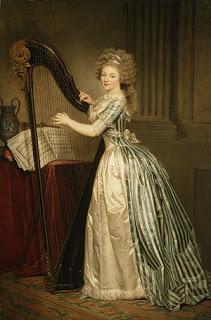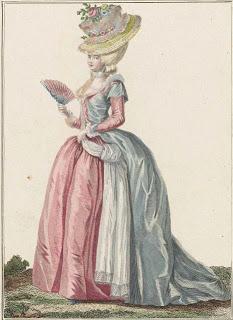The robe à la Turque was distinguished by having the upper skirts (or manteau) being of a different colour than the petticoat, sleeves and bodice/corsage. This upper skirt would often be longer than the petticoat which caused it to trail the ground. As such it was not uncommon for the upper skirts and the attached short sleeves were often not sewn together with the remaining dress - but in some cases they were. Nevertheless, the overdress was cut in one piece of fabric.
The sleeves were worn long in opposition to the quarter length sleeves of the robe à la Francaise or the robe à l'Anglaise.
It was quite common to wear a robe à la Turque with a sash around the waist. Otherwise the front resembled that of a robe à l'Anglaise with the fitted bodice forming a triangle. What makes the robe à la Turque hard to identify is the variations. Some had longer sleeves than others while some did not necessarily have a sash.
+Marquise+de+Aguessenau+wearing+a+robe+a+la+turque+1789.jpg) |
| Henriette Anne d'Aguesseau wearing a robe à la Turque, 1789 |
 |
| Self-portrait by Rose-Adélaide Ducreux |
 |
| Robe à la Turque as seen on a fashion plate |
 |
| This fashion plate clearly shows the difference between the upper skirts and the petticoat |

I believe that the first image you placed, 'Elisabeth Vigée le Brun' is actually a portrait of Henriette Anne Louise d'Aguesseau, the mother of Adrienne de La Fayette. Le brun is the painter, not the subject.
ReplyDeleteI did a little research on the portrait and it would seem that you are right! Madame Vigée le Brun painted it in 1789, so the original source I found must have been mistaken. Thank you for pointing it out :)
Delete